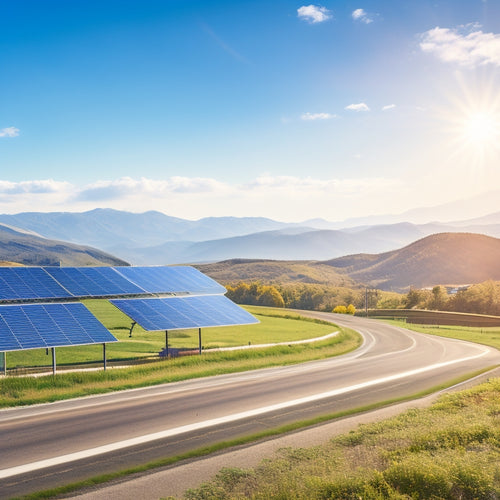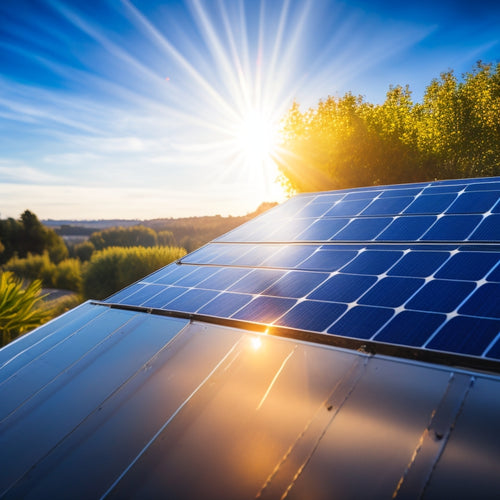
7 Energy Storage Tips for Homeowners
Share
To get the most out of your energy storage system, start by evaluating your energy needs, including tracking consumption patterns, assessing appliance efficiency, and identifying peak usage periods. Choose a battery that aligns with your needs and budget, considering factors like performance, cost, and warranty options. Size your system accurately, factoring in energy usage patterns and appliance types, and verify it meets safety standards. Maximize solar power generation by optimizing panel orientation and tilt, and investigate available incentives. By following these tips, you'll be well on your way to optimizing your energy storage system - and there's even more to uncover as you tailor your system to your unique needs.
Overview
- Conduct an energy needs assessment to determine your energy consumption patterns and identify areas for improvement.
- Choose the right battery type based on your energy needs, budget, and performance requirements, considering factors like depth of discharge and cycle life.
- Optimize your solar panel orientation and tilt to maximize energy generation, and explore available incentives for solar power system investments.
- Implement energy usage management strategies, such as shifting non-essential loads to off-peak hours, to reduce costs and maximize storage benefits.
- Ensure proper installation, maintenance, and monitoring of your energy storage system to ensure optimal performance and extend battery lifespan.
Assessing Your Energy Needs
When it comes to energy storage, understanding your energy needs is vital. You need to determine your daily energy consumption patterns to size your energy storage system correctly.
Start by tracking your energy consumption over a year to account for seasonal variation. It's also important to evaluate the energy efficiency of your home, as energy-efficient homes can reduce their energy consumption and lower their overall costs energy efficiency measures.
Identify your peak usage periods, such as summer afternoons when you're running the AC, and your low-usage periods, like winter nights when you're using minimal lighting. This data will help you determine the capacity of your energy storage system.
Reflect on factors like your appliances' wattage, their usage frequency, and the number of hours you need to power your home during an outage. By analyzing your energy needs, you'll be able to design an energy storage system that provides you with the freedom and independence you desire.
Choosing the Right Battery
When choosing a battery for your energy storage system, you'll need to take into account several key factors.
First, you'll want to select a battery type that aligns with your energy needs and budget, as different chemistries offer varying performance and cost profiles. You can investigate top-rated solar battery brands such as Tesla and LG for reliability and durability.
Additionally, evaluating the warranty options, maintenance requirements, and performance in harsh conditions will help you make an informed decision.
You'll also need to contemplate the depth of discharge, cycle life expectancy, and other critical specifications to guarantee your battery meets your requirements.
Battery Type Matters
Across various applications, from renewable energy systems to backup power solutions, the type of battery you choose plays a critical role in determining the overall performance and efficiency of your energy storage system.
You'll want to take into account lithium batteries, which offer advantages like longer battery longevity and lower environmental impact. In contrast, lead acid batteries have drawbacks such as shorter lifespans and higher maintenance requirements.
Top-rated solar battery systems, such as those from SimpliPhi Power, prioritize safety and reliability. Cost considerations, installation processes, and performance metrics also vary between battery types.
Ascertain you choose a battery that meets safety standards and takes advantage of technology advancements. By selecting the right battery, you'll enjoy a reliable and efficient energy storage system that supports your path towards energy independence.
Depth of Discharge
Your energy storage system's performance hinges on the Depth of Discharge (DoD), a critical factor to contemplate when choosing the right battery.
DoD refers to the percentage of a battery's capacity that's used during each discharge cycle. A higher DoD means you'll use more of your battery's capacity, but it can also reduce its lifespan.
You'll want to balance discharge efficiency with safe discharging practices. A deeper DoD can provide more energy, but it may also lead to faster degradation.
Look for batteries with a high DoD, typically above 80%, for peak performance. However, be certain to follow the manufacturer's guidelines to guarantee safe and efficient operation.
Cycle Life Expectancy
In selecting the right battery for your energy storage system, you'll want to take into account another crucial factor: Cycle Life Expectancy. This refers to the number of charge and discharge cycles a battery can handle before its capacity starts to degrade. Cycle longevity factors, such as the battery's chemistry and design, greatly impact its performance over time.
| Battery Type | Cycle Life Expectancy | Impact on Performance |
|---|---|---|
| Lead-Acid | 200-500 cycles | Moderate capacity loss |
| Lithium-Ion | 3,000-5,000 cycles | Minimal capacity loss |
| Flow Battery | 10,000+ cycles | Negligible capacity loss |
| Sodium-Ion | 2,000-3,000 cycles | Slight capacity loss |
When choosing a battery, consider the cycle life expectancy to guarantee you get the most out of your energy storage system.
Sizing Your Energy Storage
When sizing your energy storage system, you'll need to accurately assess your power needs, factoring in elements like your home's energy usage patterns and the types of appliances you want to power.
Next, you'll choose a battery type that meets your specific requirements, considering factors like depth of discharge, cycle life, and compatibility with your existing infrastructure.
Assessing Power Needs
Sizing your energy storage system requires a thorough understanding of your power needs. To accurately assess your energy consumption, you'll need to determine your peak demand, which is the maximum amount of power you'll need at any given time. This typically occurs in the evening when you're using multiple appliances simultaneously.
| Appliance | Power Requirement (Watts) |
|---|---|
| Refrigerator | 100-200 |
| Air Conditioner | 500-1000 |
| Electric Oven | 2000-3000 |
| Lighting and Electronics | 100-500 |
Choosing Battery Type
Your energy storage system's battery type plays a critical role in determining its overall performance and cost. When choosing a battery type, you'll likely consider lithium chemistry, which offers a longer lifespan and higher efficiency compared to lead acid batteries.
However, lithium batteries come at a higher upfront cost. You'll need to weigh the cost analysis against the benefits of a longer battery lifespan and reduced environmental impact.
Installation considerations, such as space and ventilation requirements, will also influence your decision. Look for brands with a strong reputation, extensive warranty options, and responsible recycling practices.
Don't forget to evaluate safety measures, such as built-in protection against overheating and electrical surges. By carefully considering these factors, you'll find the right battery type to meet your energy storage needs.
Calculating System Size
About 10-20% of your daily energy usage should be stored in your energy storage system to guarantee a dependable backup power supply during grid outages.
To calculate the ideal system size, you'll need to determine your average daily energy usage in kilowatt-hours (kWh). Consider your energy-intensive appliances and devices, as well as your overall energy consumption patterns.
Next, factor in system efficiency, which can range from 90% to 95%. Load balancing is also vital, as it ascertains that your system can handle peak energy demands.
Maximizing Solar Power Generation
Optimizing your solar panel array's orientation and tilt is essential to maximizing solar power generation.
You'll want to position your panels to capture the most sunlight throughout the day. A south-facing orientation is ideal, but if that's not possible, you can still generate significant power with an east- or west-facing array.
The tilt of your panels should be adjusted based on your location and the time of year. Proper orientation and tilt can increase energy production by up to 40%.
Additionally, many energy storage incentives are available for homeowners who invest in solar power systems. By maximizing your solar power generation, you'll be able to store excess energy and reduce your reliance on the grid, giving you more freedom and control over your energy usage.
Optimizing Energy Storage Location
Since you've maximized your solar power generation, it is vital to focus on optimizing energy storage location to guarantee seamless integration with your solar power system. Now, it is important to take into account the location of your energy storage system to guarantee efficient energy flow.
| Location Considerations | Installation Guidelines |
|---|---|
| Dry, cool areas | Avoid areas with high humidity and temperatures above 80°F (27°C) |
| Close to the main electrical panel | Minimize wiring distances to reduce energy losses |
| Away from flammable materials | Maintain a safe distance from combustible materials |
| Easy access for maintenance | Allow for simple troubleshooting and replacement of components |
| Protected from physical damage | Install in a secure location to prevent accidental damage |
Managing Energy Usage Patterns
Your energy storage system is only as effective as the energy usage patterns it's designed to support. To maximize its benefits, you need to understand your energy habits and adjust them accordingly.
Analyze your usage trends to identify areas of inefficiency and opportunities for improvement. For instance, if you notice a spike in energy consumption during peak hours, consider shifting non-essential loads to off-peak hours.
Monitoring and Maintaining Systems
Now that you've optimized your energy usage patterns, it's time to focus on guaranteeing your energy storage system operates at peak performance.
To do this, you'll need to establish a regular maintenance schedule to troubleshoot issues before they affect system performance. Employ monitoring software to track your system's energy efficiency and identify areas for improvement.
Additionally, follow installation guidelines and safety precautions to ascertain your system is installed correctly and safely. Regular maintenance will also help extend your battery lifespan, saving you money in the long run.
Frequently Asked Questions
Can Energy Storage Systems Be Used for Backup Power During Outages?
You can employ energy storage systems as a reliable backup power source during outages, enjoying home battery benefits like uninterrupted electricity and outage preparedness, giving you the freedom to stay connected and comfortable when the grid goes down.
Are Energy Storage Systems Compatible With All Solar Panel Brands?
As you're planning your solar setup, you'll find that it's not just a coincidence that top manufacturers design their systems for seamless integration. You'll uncover that most energy storage systems are compatible with various solar panel brands, ensuring a smooth integration for maximum energy freedom.
Do Energy Storage Systems Require Frequent Replacement of Batteries?
You'll be pleased to know that you won't need to replace energy storage system batteries frequently; in fact, most batteries have a lifespan of 10-15 years, with minimal maintenance requirements, ensuring a hassle-free experience and maximum energy independence.
Can I Use My Energy Storage System for EV Charging?
You can use your energy storage system for EV charging, increasing energy efficiency by optimizing your home's energy usage; however, you'll need to ascertain your system is compatible and configured properly to support the added load of EV charging.
Are Energy Storage Systems Eligible for Federal Tax Credits?
As you traverse the path to energy independence, you'll find that yes, you can utilize the power of federal tax credits for your energy storage system, unfastening installation incentives and energy efficiency benefits that'll fuel your expedition to freedom.
Ready to Buy
By following these energy storage tips, you'll be well on your way to utilizing the power of your home's energy like a skilled conductor leading an orchestra. Just as a talented musician knows exactly when to strike the right chord, you'll know exactly when to store and release energy to maximize efficiency. With the right system in place, you'll be saving energy - and money - in perfect harmony.
Related Posts
-

Is Switching to Green Energy Solutions Easy
Switching to green energy solutions isn't just easy; it's also beneficial. You can greatly cut utility costs and enjo...
-

How Efficient Are Thin Film Solar Cells
Thin film solar cells provide an innovative approach to energy generation, boasting efficiency rates generally betwee...
-

Top Off Grid Solar Batteries for Renewable Energy
When seeking top off-grid solar batteries for renewable energy, consider options with advanced battery chemistry, suc...


